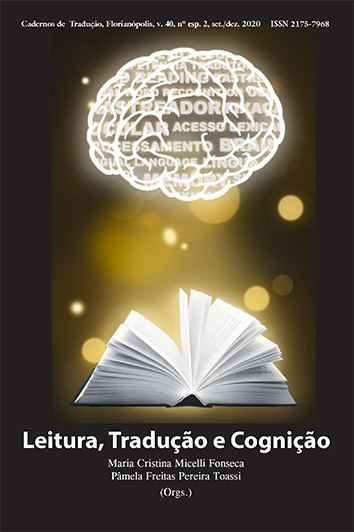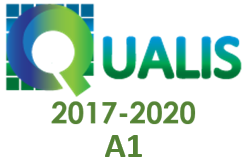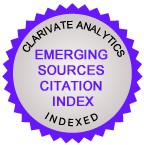Form and content anomalies in Brazilian Portuguese: a preliminary eye-tracking study of reading and acceptability evaluation
DOI:
https://doi.org/10.5007/2175-7968.2020v40nesp2p45Abstract
The present study uses the eye tracking methodology to investigate to what extent the reading of sentences in Brazilian Portuguese may differ in relation to grammatical and semantic anomalies and how these sentences are evaluated for their good formation, taking as control syntactically and semantically well-formed sentences. The analyses of the on-line data, allowed us to identify that sentences that present anomalous number agreement features in the object noun phrase are more costly in terms of fixation and refixation patterns than the semantic anomalous sentences, even though they may be better accepted by educated speakers in the off-line measure than sentences with semantic anomalies. It is argued that the results provide evidence in favor of structural models of sentence processing.
References
Boland, Julie E. “The relationship between syntactic and semantic processes in sentence comprehension.” Language and Cognitive Processes. 12.4, (1997): 423-484.
Braze, David, et al. “Readers’ eye movements distinguish anomalies of form and content”. Journal of psycholinguistic research. 31.1, (2002): 25-44.
Chomsky, Noam. Syntactic structures. The Hague: Mouton, 1957. Chomsky, Noam. “Aspects of the Theory of Syntax. 11”. Cambridge, MA: MIT Press, 1965.
Epstein, William. “The influence of syntactical structure on learning”. The American Journal of Psychology. 74.1, (1961): 80-85.
Ferreira, Fernanda; Karl GD Bailey; Ferraro, Vittoria. “Good-enough representations in language comprehension”. Current directions in psychological science. 11.1, (2002): 11-15.
Fodor, Janet Dean, et al. “Tasks and timing in the perception of linguistic anomaly”. Journal of Psycholinguistic Research. 25.1, (1996): 25-57.
França, Aniela Improta. Concatenações linguísticas: estudo de diferentes módulos cognitivos na aquisição e no córtex. Tese de Doutorado. Rio de Janeiro: Universidade Federal do Rio de Janeiro, 2002.
Frazier, Lyn. On comprehending sentences: Syntactic parsing strategies. Doctoral dissertation, University of Connecticut (1979).
Frazier, Lyn; Fodor, Janet Dean. “The sausage machine: A new two-stage parsing model”. Cognition. 6.4, (1978): 291-325.
Frazier, Lyn; Rayner, Keith. “Making and correcting errors during sentence comprehension: Eye movements in the analysis of structurally ambiguous sentences”. Cognitive psychology. 14.2, (1982): 178-210.
Friederici, Angela D.; Pfeifer, Erdmut; Hahne, Anja. “Event-related brain potentials during natural speech processing: Effects of semantic, morphological and syntactic violations”. Cognitive brain research. 1.3, (1993): 183-192.
Kutas, Marta; Hillyard, Steven A. “Reading between the lines: Event-related brain potentials during natural sentence processing”. Brain and Language. 11.2, (1980): 354-373.
MacDonald, Maryellen C.; Pearlmutter, Neal J.; Seidenberg, Mark S. “The lexical nature of syntactic ambiguity resolution”. Psychological review. 101.4, (1994): 676.
Maia, Marcus (a). “Linguística experimental: aferindo o curso temporal e a profundidade do processamento”. Revista de Estudos da Linguagem. 21.1, (2013): 9-42.
Maia, Marcus. (Org.) (b). Psicolinguística e Metacognição na Escola. Campinas: Mercado de Letras, 2019.
McElree, Brian; Griffith, Teresa. “Syntactic and thematic processing in sentence comprehension: Evidence for a temporal dissociation”. Journal of Experimental Psychology: Learning, Memory, and Cognition. 21.1, (1995): 134.
Miller, George A.; Isard, Stephen. “Free recall of self-embedded English sentences”. Information and Control. 7.3, (1964): 292-303.
Osterhout, Lee; Holcomb, Phillip J. “Event-related brain potentials elicited by syntactic anomaly”. Journal of memory and language. 31.6, (1992): 785-806.
Ribeiro, Antonio João Carvalho. “Late Closure e Good-Enough no processamento de frases garden-path do português do Brasil: evidências de eyetracking”. ReVEL. 10.18, (2012).
Trueswell, John C.; Tanenhaus, Michael K.; Garnsey, Susan M. “Semantic influences on parsing: Use of thematic role information in syntactic ambiguity resolution”. Journal of memory and language. 33.3, (1994): 285-318.
Trueswell, John C.; Tanenhaus, Michael K.; Kello, Christopher. “Verb-specific constraints in sentence processing: separating effects of lexical preference from garden-paths”. Journal of Experimental psychology: Learning, memory, and Cognition. 19.3, (1993): 528.
Yang, Yang; Wu, Fuyun; Zhou, Xiaolin. “Semantic processing persists despite anomalous syntactic category: ERP evidence from Chinese passive sentences”. PloS one, 10.6 (2015).
Downloads
Published
How to Cite
Issue
Section
License
Copyright (c) 2020 Cadernos de Tradução

This work is licensed under a Creative Commons Attribution 4.0 International License.
Copyright Notice
Authors hold the copyright and grant the journal the right for their articles' first publication, being their works simultaneously licensed under the Creative Commons Attribution License (CC BY), which allows the sharing of such works with its authorship acknowledged and its initial publication in this journal.
Authors are allowed to enter into separate additional contractual arrangements for the non-exclusive distribution of the journal's published version of the work (e.g., post it to an institutional repository or as a book chapter, with an acknowledgment of its initial publication in this journal).






















































